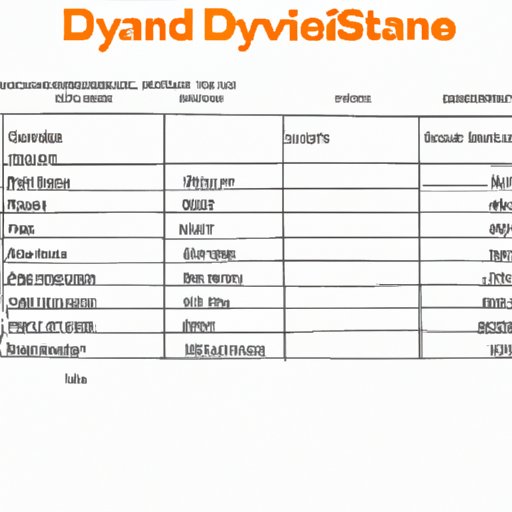Introduction
Dividends are a key component of many investor’s portfolios. They provide a steady source of income and can be used to supplement other investments. To take full advantage of dividends, however, investors must first understand how they are calculated and where they can be found in financial statements. This article will provide a comprehensive guide on how to find dividends in financial statements.
Analyzing the Income Statement
The income statement is one of the primary documents used by investors to identify dividend opportunities. It provides information on a company’s revenues, expenses, and net income. The net income figure is the amount of money a company has left over after all costs have been paid. This figure is then divided by the number of outstanding shares of stock to calculate the earnings per share (EPS). This figure is important because it is used to determine how much of that profit will be paid out as dividends.
To calculate dividends from an income statement, investors must first look at the “dividends declared” line item. This line item will show the total amount of dividends that were declared during the period covered by the income statement. From here, investors can divide this figure by the number of outstanding shares to get the per share dividend amount. For example, if the company declared $1 million in dividends and there are 10 million outstanding shares, the per share dividend would be $0.10.
Examining the Balance Sheet
The balance sheet is another important document for investors looking for dividend opportunities. It provides information on a company’s assets, liabilities, and shareholders’ equity. Investors can use the balance sheet to search for dividends in two ways. First, they can look at the “retained earnings” line item. This line item shows the total amount of profits retained by the company over time. If the company has a large amount of retained earnings, it may be more likely to pay out larger dividends.
The second way to use the balance sheet to search for dividends is to examine the “cash and equivalents” line item. This line item shows the total amount of cash and liquid assets held by the company. Companies with large amounts of cash and liquid assets may be more likely to pay out higher dividends.
Exploring Cash Flow Statements
Cash flow statements are another important document for investors looking for dividend opportunities. They provide information on a company’s cash inflows (such as sales and investments) and outflows (such as operating expenses and capital expenditures). Investors can use cash flow statements to search for dividends in two ways. First, they can look at the “dividends paid” line item. This line item shows the total amount of dividends that were paid out during the period covered by the cash flow statement.
The second way to use the cash flow statement to search for dividends is to examine the “cash provided by operating activities” line item. This line item shows the total amount of cash generated by the company’s operations. Companies with high levels of cash generation may be more likely to pay out higher dividends.
Calculating Dividend Payout Ratios
In addition to using financial statements to search for dividend opportunities, investors can also calculate dividend payout ratios. These ratios measure how much of a company’s profits are paid out as dividends. The formula for calculating the dividend payout ratio is:
Dividend Payout Ratio = (Dividends Paid / Earnings Per Share) x 100
For example, if a company has an EPS of $2.50 and pays out $1.00 in dividends, its dividend payout ratio would be 40%. This means that 40% of the company’s profits are paid out as dividends.
Observing the Company’s History of Dividend Payments
Finally, investors can use a company’s past dividend payments to determine its future dividend potential. By looking at a company’s past dividend payments, investors can get an idea of how much the company is likely to pay out in the future. They can also look for patterns in the company’s dividend payments, such as whether the company is increasing or decreasing its dividend payments over time.
Investors can look at a company’s past dividend payments by examining the “dividends declared” line item in the income statement. This line item shows the total amount of dividends that were declared during the period covered by the income statement.
Conclusion
Finding dividends in financial statements can be a tricky task. It requires investors to understand the different types of financial statements and how to use them to locate dividend opportunities. By analyzing the income statement, examining the balance sheet, exploring cash flow statements, calculating dividend payout ratios, and observing the company’s past dividend payments, investors can take full advantage of dividend investing.
By following the steps outlined in this article, investors can confidently search for dividend opportunities in financial statements. With the right knowledge and tools, investors can maximize their dividend income and build a strong portfolio.
(Note: Is this article not meeting your expectations? Do you have knowledge or insights to share? Unlock new opportunities and expand your reach by joining our authors team. Click Registration to join us and share your expertise with our readers.)
